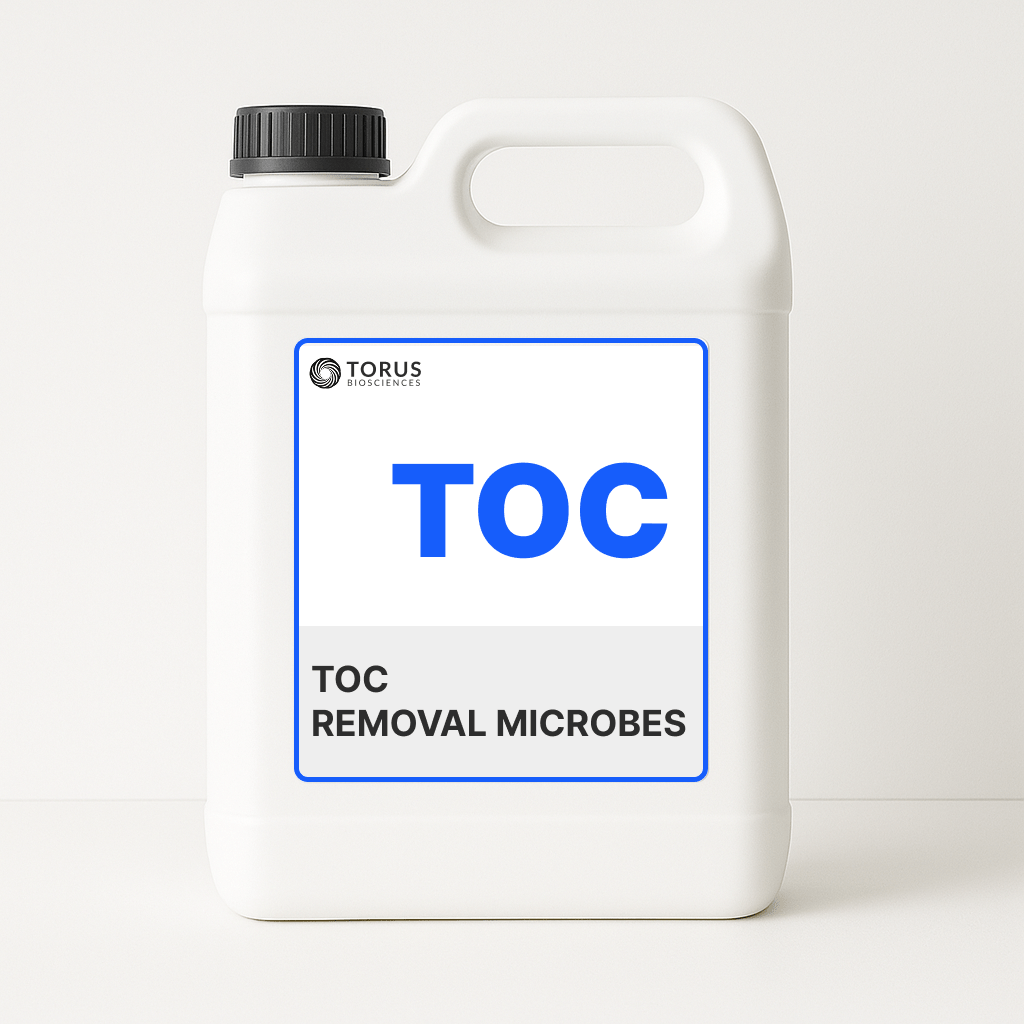
TOC Removal Microbes
Advanced microbial formulation for effective reduction of Total Organic Carbon (TOC) in industrial and municipal wastewater.

Torus TOC Removal is a specialized consortium of microorganisms specifically selected and cultivated for their ability to metabolize diverse organic compounds in wastewater. This advanced microbial formulation efficiently degrades complex carbon molecules into simple compounds, ultimately converting them to carbon dioxide and water, significantly reducing the Total Organic Carbon (TOC) content in effluent streams.
Extensive field applications demonstrate that this microbial consortium can achieve TOC reduction rates of 60-90% in various industrial and municipal wastewater streams, helping facilities meet increasingly stringent discharge regulations while reducing treatment costs and environmental impact compared to conventional chemical treatment methods.
Benefits
-
Superior TOC Reduction: The microbial consortium achieves 60-90% TOC removal efficiency depending on wastewater composition and treatment conditions. This biological approach targets both dissolved and particulate organic carbon through multiple metabolic pathways, addressing a broader spectrum of compounds than physical or chemical treatments alone.
-
Reduced Chemical Usage: Implementation of this microbial solution typically decreases chemical oxidant requirements by 40-70% in treatment plants, significantly reducing operating costs and minimizing the formation of potentially harmful disinfection byproducts associated with chemical oxidation processes.
-
Enhanced Treatment System Performance: The formulation improves overall wastewater treatment plant functioning by reducing organic loading on downstream processes, preventing bulking and foaming in activated sludge systems, and extending the service life of filtration systems and membranes by minimizing organic fouling.
-
Lower Sludge Production: Compared to conventional activated sludge processes, this specialized consortium produces 15-30% less excess biomass due to more complete mineralization of organic matter and efficient metabolic pathways, reducing sludge handling and disposal costs.
-
Improved Discharge Compliance: The comprehensive degradation capabilities ensure consistent compliance with increasingly stringent regulatory standards for effluent quality. The technology addresses hard-to-treat organics that often cause compliance issues with conventional treatment systems.
-
Odor Reduction: The microbial formulation efficiently degrades odor-causing compounds like volatile fatty acids, amines, and sulfur-containing organics, reducing or eliminating offensive odors associated with organic-rich wastewaters.
-
Eco-friendly Treatment: The biological approach eliminates the need for harsh chemicals and minimizes the formation of hazardous byproducts, creating a more environmentally sustainable treatment process with a smaller carbon footprint than conventional chemical treatments.
Applications
Industrial Wastewater Treatment:
-
Pulp and Paper Industry: The consortium effectively treats high-COD/TOC effluents containing lignin, tannins, and resin acids from pulping and bleaching processes. Treatment systems using these microbes have demonstrated 65-85% TOC reduction in paper mill effluents that conventional systems struggle to treat due to the recalcitrant nature of wood-derived compounds.
-
Textile Manufacturing: The microbial formulation degrades complex dyes, sizing agents, and surfactants common in textile effluents. The specialized enzymes produced by consortium members (azoreductases, laccases, peroxidases) break down azo dyes and other color-bearing compounds that resist conventional treatment, achieving 70-90% color removal alongside TOC reduction.
-
Chemical Processing: In chemical manufacturing wastewater containing diverse organic compounds, the consortium adapts to metabolize multiple substrates simultaneously. The microbial community’s genetic diversity allows it to develop pathways for degrading even novel synthetic compounds after a brief acclimation period.
-
Food and Beverage Production: High-strength organic wastewaters from food processing, breweries, and distilleries are effectively treated with TOC reductions of 80-95%. The microbes rapidly metabolize sugars, starches, proteins, and fats while preventing the anaerobic conditions that lead to odor problems in these high-BOD wastewaters.
-
Pharmaceutical Manufacturing: The formulation addresses pharmaceutical wastewaters containing complex organic molecules, solvents, and intermediate compounds. The adaptive capacity of the consortium allows it to develop metabolic pathways for degrading recalcitrant pharmaceutical compounds that might otherwise pass through conventional treatment systems.
-
Petroleum and Petrochemical Processing: Refineries and petrochemical plants generate wastewaters containing oils, phenols, and aromatic compounds that the consortium can effectively degrade. The hydrocarbon-degrading capabilities of the specialized microbes are particularly valuable for these applications.
Municipal and Other Applications:
-
Municipal Wastewater Treatment: The consortium enhances conventional activated sludge processes, improving TOC removal efficiency while addressing micropollutants of emerging concern like pharmaceutical residues and personal care products that conventional treatment misses.
-
Landfill Leachate Treatment: Highly concentrated leachate from waste disposal sites contains a complex mixture of organic compounds that the microbial formulation can degrade, reducing the high TOC levels typically found in these challenging waste streams.
-
Agricultural Runoff Treatment: The microbial solution helps remediate agricultural wastewater containing pesticides, herbicides, and organic matter from livestock operations, reducing nutrient loading and organic pollution in receiving water bodies.
-
Groundwater Remediation: In situ or ex situ treatment of contaminated groundwater is possible using the consortium, which can degrade organic contaminants like solvents, petroleum hydrocarbons, and chlorinated compounds that affect groundwater quality.
For optimal results, the TOC Removal Microbes should be introduced into wastewater treatment systems at points that maximize contact time with the organic contaminants. Regular dosing maintains an effective population of specialized degraders, while periodic bioaugmentation addresses changing wastewater characteristics or system upsets.
This biological approach to TOC reduction represents a sustainable alternative to chemical treatment methods, offering comprehensive organic carbon removal while minimizing environmental impact, reducing operational costs, and helping facilities achieve consistent regulatory compliance even with challenging waste streams.
Key Microorganisms
Heterotrophic Bacteria: The formulation contains robust strains of specialized carbon-degrading bacteria that excel at breaking down a wide spectrum of organic compounds. These bacteria possess diverse metabolic pathways and can produce extracellular enzymes capable of degrading recalcitrant substances including aromatic compounds, long-chain hydrocarbons, and complex organic polymers. The primary degraders in the consortium can metabolize over 90 different carbon compounds and adapt rapidly to changing wastewater compositions.
Specialized Degraders: The consortium includes targeted degraders that address specific problematic compounds often found in industrial wastewaters. These specialists can metabolize phenols, tannins, surfactants, and other molecules that conventional treatment systems struggle to remove. The formulation contains proprietary bacterial strains with genes coding for specialized degradative enzymes that can be transferred horizontally within the microbial community, enhancing the overall degradation capacity.
Biofilm Formers: Select bacterial strains in the formulation facilitate the formation of robust biofilms on various surfaces within treatment systems. These biofilms create microenvironments with stratified oxygen gradients, allowing for both aerobic and anoxic degradation processes to occur simultaneously, significantly enhancing the range of compounds that can be metabolized.
Mechanism of Action
-
Enzymatic Degradation: The microbial consortium produces a comprehensive array of extracellular and intracellular enzymes that break complex organic molecules into simpler compounds:
- Oxidoreductases attack aromatic rings and other stable structures
- Hydrolases cleave ester, amide, and glycosidic bonds
- Dehalogenases remove halogen atoms from chlorinated compounds
- Lyases break carbon-carbon bonds in various organic molecules
-
Cometabolic Processes: Certain difficult-to-degrade compounds are broken down through cometabolism, where microbes using one carbon source produce enzymes that incidentally degrade other compounds that would not support growth on their own. This mechanism is particularly important for trace contaminants and recalcitrant compounds.
-
Adaptive Response: The microbial community adapts to changing wastewater composition through genetic regulation, enzyme induction, and plasmid transfer, allowing for the development of new metabolic capabilities in response to novel compounds.
-
Biofilm Formation: Microbial cells attach to surfaces and develop structured biofilms with distinct microenvironments that support diverse metabolic activities. These biofilms enhance contaminant removal through increased retention time, high cell density, and protection from environmental stressors.
-
Synergistic Interactions: Different microbial species in the consortium work together in complementary metabolic networks. Partial degradation products released by one species serve as growth substrates for others, enabling complete mineralization of complex compounds through sequential biological reactions.
-
Aerobic and Facultative Metabolism: The consortium functions effectively across various dissolved oxygen levels, with different members active under aerobic, microaerophilic, or anoxic conditions. This versatility ensures continuous organic carbon degradation even in oxygen-limited zones of treatment systems.
Available Variants




Boost productivity with our sustainable biological solutions.
Trusted by agricultural and waste management professionals for superior results.
Request pricing & availability